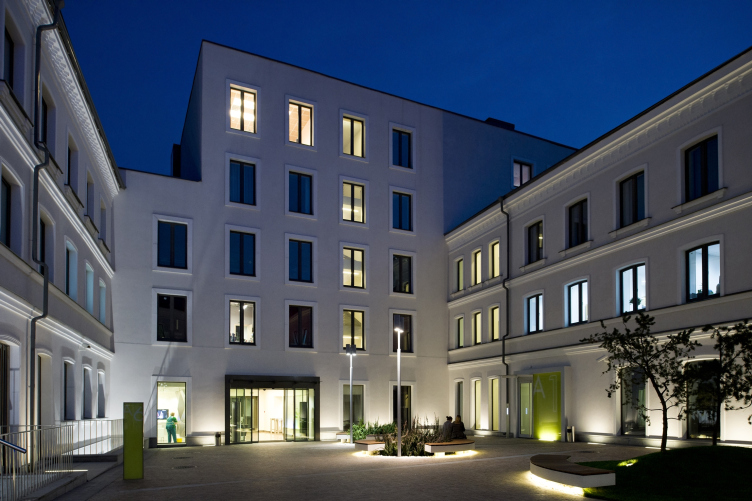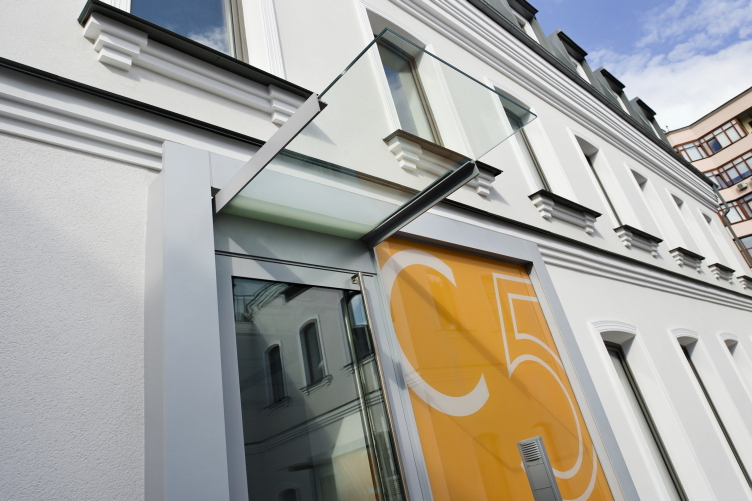Nearby Novoslobodskaya Metro Station, next to the Palikha Street, there have been completed the transformation of two small factory buildings of the early XX century - the sowing factory "Salute" and the studio "Reklamfilm" - into the state-of-the-art business block "Atmosphere" by ADM Bureau.
We already wrote about the project of this business block two years ago, and now it has been implemented. Already in summer, the occupiers appeared here, while, from the cafe in front of the entrance the enticing aromas started to carry - the block came alive. "It makes you feel great to see people come out into the courtyards, sit in the benches, visit with one another, and have their coffees. This is a very peaceful environment; it is very quiet here because the territory is completely vehicle-free. This environment of a European city that we designed and advertised has finally become a reality" - proudly confesses the leader of ADM Architectural Bureau Andrew Romanov. The architects opened their office here as well - in the best traditions - in the environment that they created with their own hands, and they continue seeing how life is developing in this, though small, but really cozy business block.
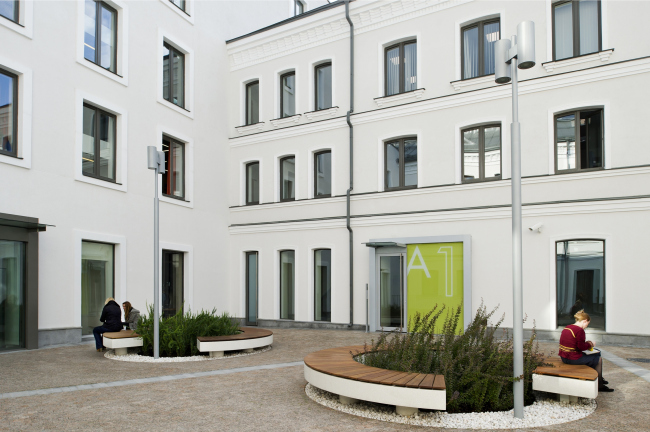
Office complex "Atmosphere" (reconstruction). © ADM
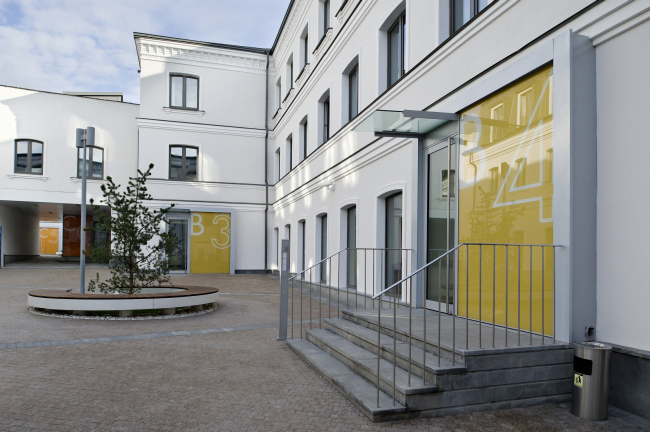
Office complex "Atmosphere" (reconstruction). © ADM
At this point we will remind you that the authors of the reconstruction project were able to keep, while clearing all the minor constructions, virtually all the main buildings of the block, the main bulk of which consisted of century-old factory buildings. The buildings were carefully cleaned and covered with light-gray stucco with white finish used to highlight the details of the modest facade decor. The Soviet-era building of the 1970's and a few smaller volumes inside the block were "re-dressed" with striped ceramic panels of a gray color matching the overall tone. The squatting windows of the Soviet-era building got vertically stretched and separated by a thin link; in their bottom part the architects added a glass plate that conceals part of the wall; the floors got separated by dark-metallic L-beams, as is wont with ADM. All of this: the striped glass, a small fraction of metal, the light-colored strokes of the ceramics - makes the contemporary part of the complex look as light as weightless - just like the tint coating that the renovators apply to the icons: all that the new facades do is make the environment more cohesive without claiming to be anything more than a background.
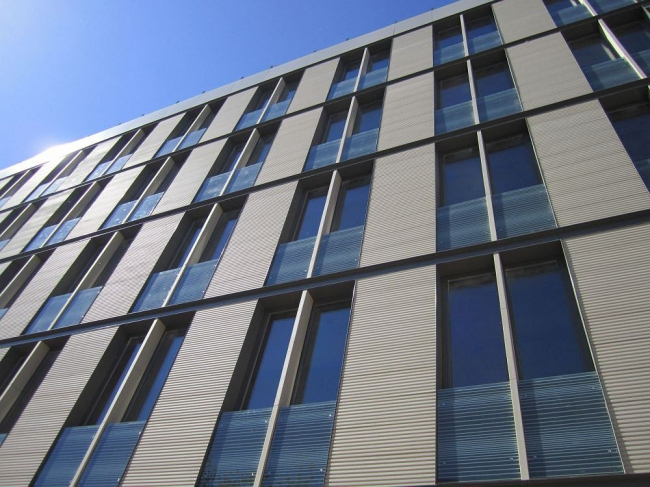
Office complex "Atmosphere" (reconstruction). © ADM
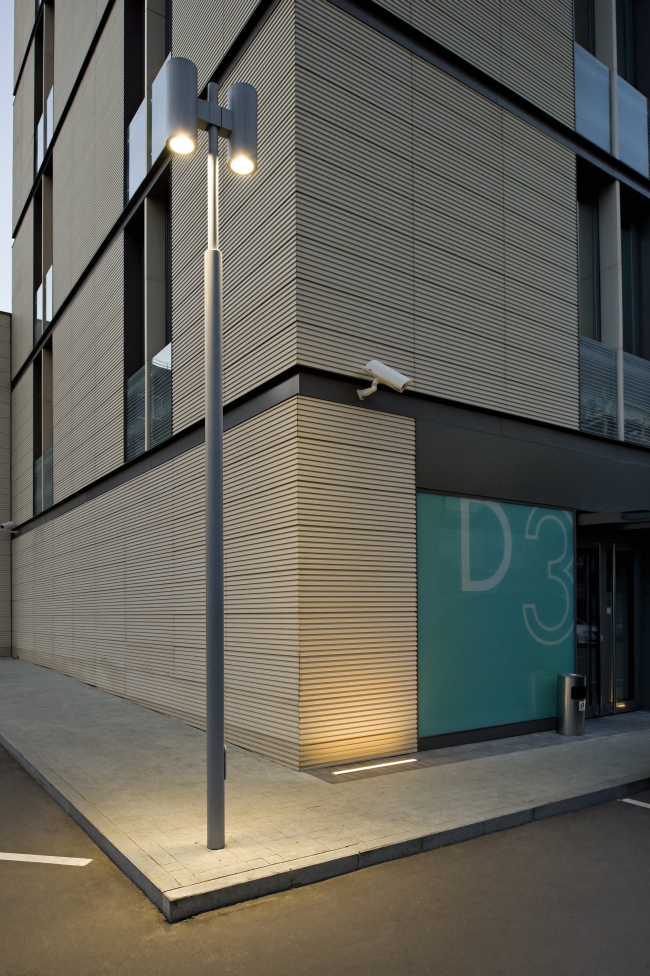
Office complex "Atmosphere" (reconstruction). © ADM
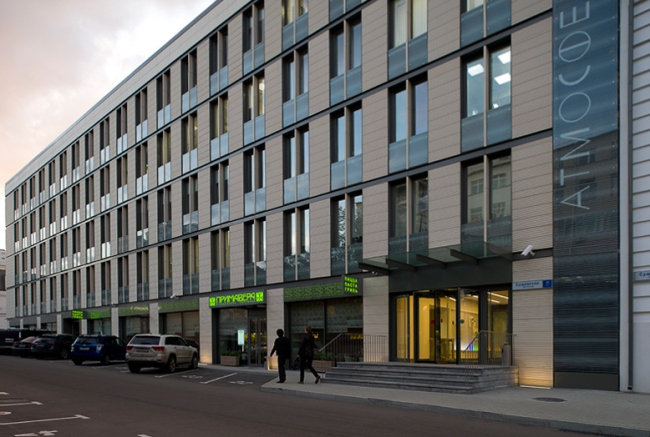
Office complex "Atmosphere" (reconstruction). © ADM
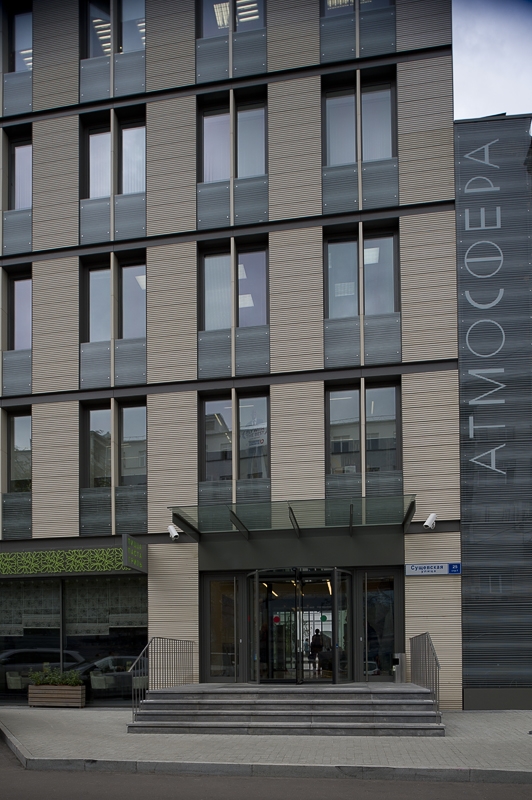
Office complex "Atmosphere" (reconstruction). © ADM
The same impression is produced, strictly speaking, by all the other facades of the early XX century here: they were and they still are the inconspicuous "rank-and-file" facades whose main objective is to serve their simple function and not draw attention. The leading part here is played not by the facades but by the very atmosphere after which, as we remember, the business block was named.
When I asked Andrew Romanov just how he came up with this self-explanatory name, he jokingly answered: "We told our customer so many times about the atmosphere that we wanted to create here that probably this finally left its mark on the name of the place!" Many a true word is spoken in jest, however, and this is exactly the case: it was the atmosphere of the courtyards that got the most of the architects' attention and it comprised all the stylistic devices and techniques - really delicate, unobtrusive but still showing every sign of attention to detail and flawless execution.
Three small vehicle-free yards form some sort of irregular chain that stretches from the old Moscow Palikha Street parallel to the Suschevskaya Street up to the Nameless Driveway. One will be able to walk through these yards end to end, even though the main entrance from the side of the checkpoint looks but conditionally open - but those who know that it IS open will be able to come in and see the result from the inside.
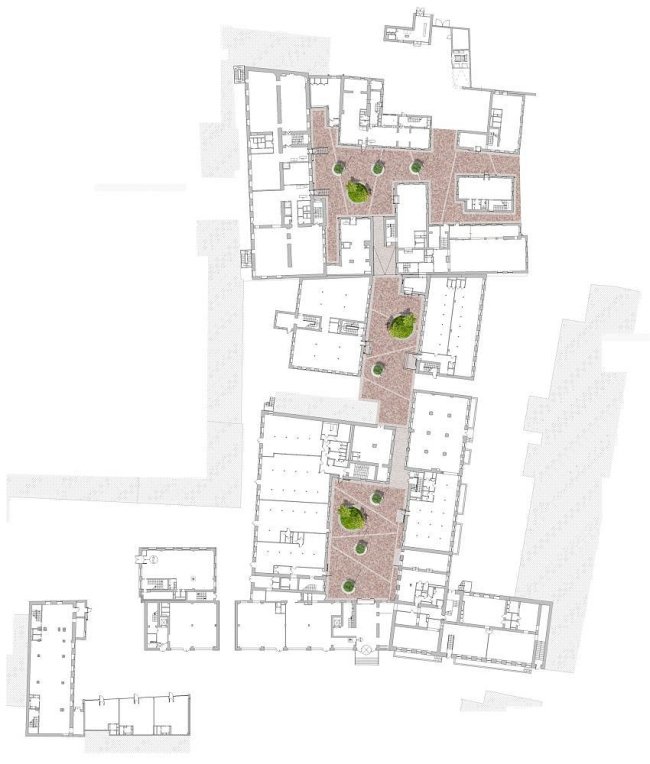
Office complex "Atmosphere" (reconstruction). © ADM. Layout
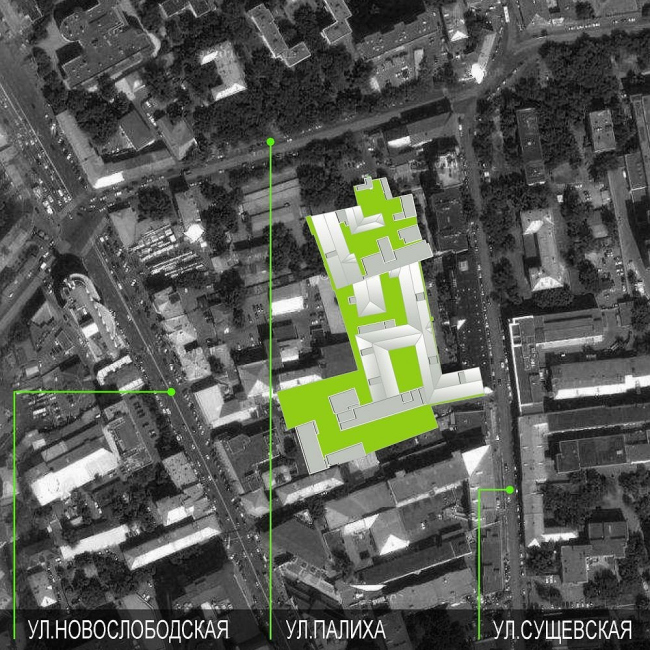
Office complex "Atmosphere" (reconstruction). © ADM. Location plan
The atmosphere begins already before the entrance, though. Turning in from the Suschevskaya Street, we find ourselves in an alley that is a little cleaner and spacious than the kind we are used to. It is here where most of the cafes and restaurants are situated that thus cater both the local office employees and the city people. On the left, there is the drastically changed Soviet building; on the right - the most luxuriant facade of the local historicism. With time, the windows of its first floor sank into the ground, and during the reconstruction the architects dug them out, organizing a rather deep areaway and thus letting in more daylight inside, the first-floor premises being occupied by the restaurants.
As we make our way between the buildings and go deeper inside, on the left and on the right we see the offices and the checkpoint; through the turnstile, however, we can get inside the courtyard. Just like the two others following behind it, it is paved with texture stone that is traversed by the diagonals of dark-gray granite that separate round flowerbeds that one cannot even really call this ordinary term, though. They look more like art objects: islets of green in the concrete, ostentatiously urban environment. Among these islets, sometimes even while islands are found: grass-covered hemispheres upon which grow sometimes one and sometimes several pine trees of the mountain variety "Bonsai". Such trees do not grow tall with time but turn into dense shrubs - explain the architects.
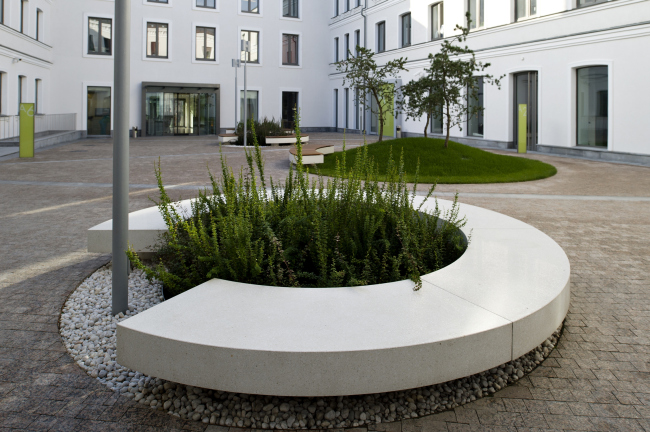
Office complex "Atmosphere" (reconstruction). © ADM
The other islets sport tassel flowers and are surrounded by punctured rings of benches made from the Belgian agglomerated white concrete. The benches are really high-quality, they were made in Belgium specifically for this project. At some places the surface of the benches is left as bare concrete but more often, for the sake of warmth, is covered by a lath of reddish Cumaru wood. The punctured rings of the benches - that resemble the signs from the ophthalmology chart - thanks to their shape, are very capacious. The short thick "legs" of the benches rest on a layer of sea pebbles that are supposedly to put the office workers into the mind of their vacation memories while they are taking a break from the pressures of huge working day.
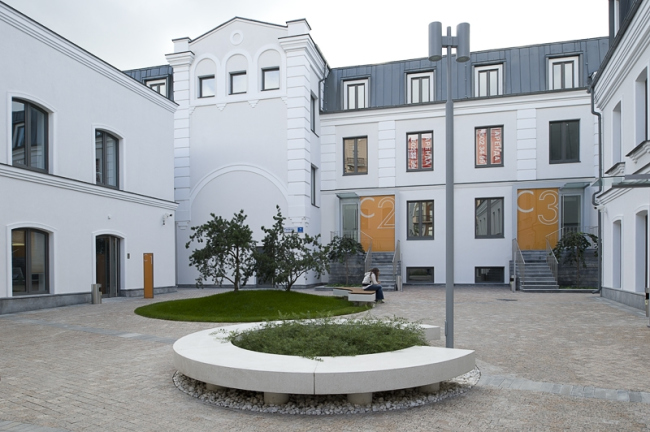
Office complex "Atmosphere" (reconstruction). © ADM
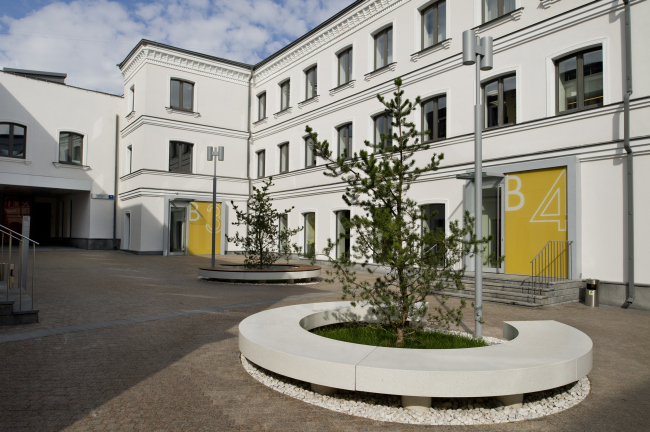
Office complex "Atmosphere" (reconstruction). © ADM

Office complex "Atmosphere" (reconstruction). © ADM
The yards are cozy in the daytime but especially great in the evening: the architects paid a lot of attention to the backlighting and executed it exactly as the project prescribed. The smooth paving stripes running along the buildings have in them thin strokes of lamps that backlight the facades from below and throw the reflected light on the lower "human" part of the yard territory. The pebbles under the benches shine glimmer in the dark as well - together with the backlighting of the walls this gives one a feeling of the ground glowing in the dark or even some "hovering" of the benches - they look like they are resting on the rings of light. The point lights in the grass of the pine tree hill give the finishing touch to the picture.
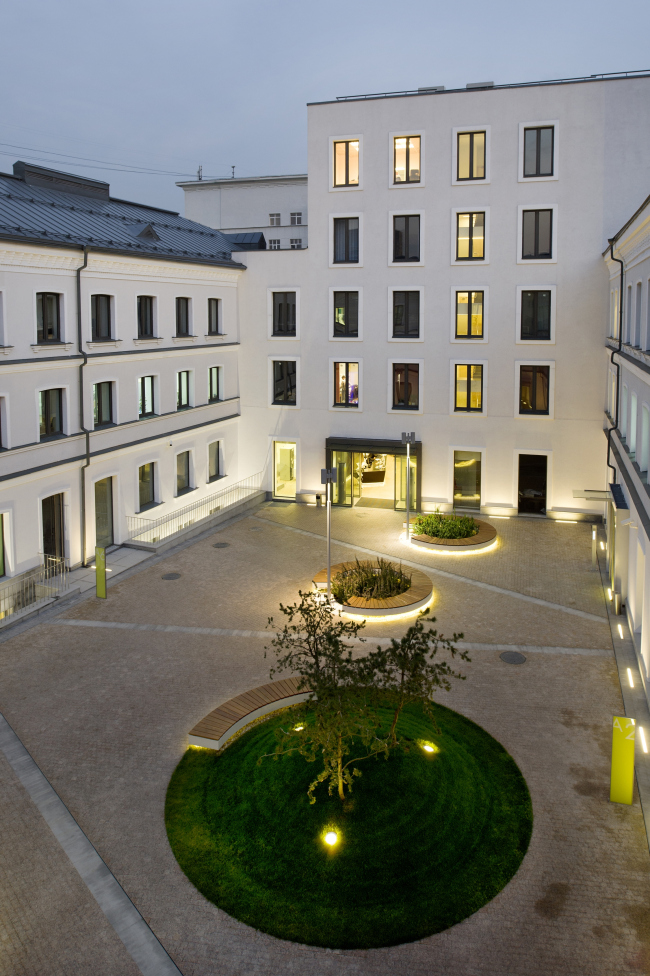
Office complex "Atmosphere" (reconstruction). © ADM
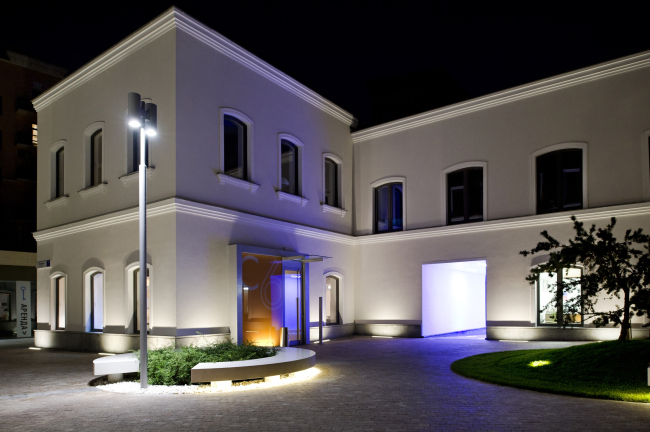
Office complex "Atmosphere" (reconstruction). © ADM
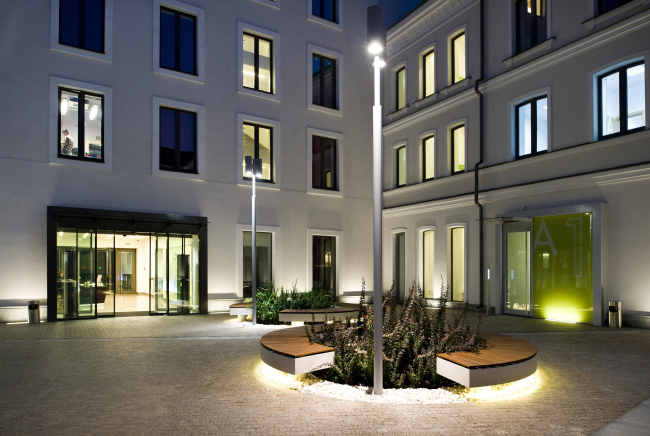
Office complex "Atmosphere" (reconstruction). © ADM

Office complex "Atmosphere" (reconstruction). © ADM
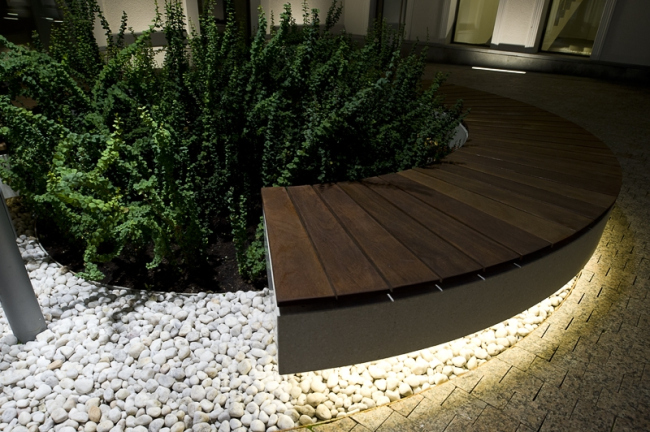
Office complex "Atmosphere" (reconstruction). © ADM
The only impregnation into the historical facades that the architects allowed themselves to make is the bright spots of color silk-screen printing with large numbers - the numbers of the buildings - on the glass of the entrance doors. The unique "color + number" combinations help the visitors to easier find their way around the block and certainly add some "light" emotional twist to the reserved atmosphere that reigns here.

Office complex "Atmosphere" (reconstruction). © ADM
The territory that the architects have been able to create must be recognized as a "model", though still expensive, impregnation of a truly contemporary environment into the cityscape. To a certain extent, this is a very neat, unostentatious imitation of Europe that is almost imperceptibly installed into the freezing slush of Moscow's alleys. For ADM architects, this reconstruction was the first in the galaxy of several similar projects that they launched later on, and it was the first one of this genre to be implemented. The successful transition to the reconstruction was by no means a walkover, and a lot of corrections were made along the way. "In spite of all the difficulties, this was a priceless experience" - Andrew Romanov shares.
Indeed, working with historical buildings is something that is fraught with a lot of unforeseen challenges of a purely down-to-earth engineering nature. Besides, despite the growing common love of the landscaping and improvement theme, it is easy to see that, while some people are still talking about it, here the work has already been completed, and we see the living proof: one can come, touch, and sit on the benches. It is terrifying just to think how much time and effort it takes for such a jewel to come into being at least in the downtown area. But - constant dropping wears away a stone - the meticulous work with stone (pun intended), light, and exotic pines - all this is just the beginning, the first growth of the trend that can possibly bear fruit with time. One just has to work harder.




















